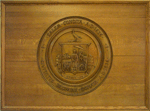Blubber Hollow: Difference between revisions
From Salem Links and Lore
No edit summary |
No edit summary |
||
| Line 3: | Line 3: | ||
*In colonial Salem, it was common for families to tan their own leather. In 1750, however, with the invention of the bark mill by Joseph Southwick of Danvers, a tanning industry became possible. | *In colonial Salem, it was common for families to tan their own leather. In 1750, however, with the invention of the bark mill by Joseph Southwick of Danvers, a tanning industry became possible. | ||
*By the mid 1850's, more than eighty tanning and currying shops were operating in the hollow and along both sides of the [[North River]], employing about 500 workers. By 1885, that number had doubled. | *By the mid 1850's, more than eighty tanning and currying shops were operating in the hollow and along both sides of the [[North River]], employing about 500 workers. By 1885, that number had doubled. | ||
*The State Senate,of old Blubber Hollow, was a spontaneous organization. Tanners were active members, as well as sea captains and sailor, merchants and mechanics. The headquarters of the Senate were at the tannery supply store of Joshua B. Grant, on Boston Street, in the heart of Blubber Hollow. Discussions were long and loud and on topics of the day. Business at the store continued around these lively talks. See Gannon's book Joshua B. | *The State Senate,of old Blubber Hollow, was a spontaneous organization. Tanners were active members, as well as sea captains and sailor, merchants and mechanics. The headquarters of the Senate were at the tannery supply store of Joshua B. Grant, on Boston Street, in the heart of Blubber Hollow. Discussions were long and loud and on topics of the day. Business at the store continued around these lively talks. See Gannon's book ''Joshua B.Grant's Store and the Salem Senate'' for more. | ||
*The leather industry suffered a blow after a five-month strike that turned violent. The industry declined, and by 1920 most of the shops had closed, being victims of labor problems, competition from Mid-west companies and scarcity of bark mulch needed for tanning. The Salem fire of 1914 burned much of the blubber hollow area and beyond, which was another set-back for the industry. | *The leather industry suffered a blow after a five-month strike that turned violent. The industry declined, and by 1920 most of the shops had closed, being victims of labor problems, competition from Mid-west companies and scarcity of bark mulch needed for tanning. The Salem fire of 1914 burned much of the blubber hollow area and beyond, which was another set-back for the industry. | ||
| Line 12: | Line 12: | ||
*[http://innopac.noblenet.org/search/X?search=tide+rises+the+tide+falls&searchscope=24&m=&SORT=D The tide rises, the tide falls; three centuries of the Salem waterfront] Salem Maritime Historic Site, p.17 | *[http://innopac.noblenet.org/search/X?search=tide+rises+the+tide+falls&searchscope=24&m=&SORT=D The tide rises, the tide falls; three centuries of the Salem waterfront] Salem Maritime Historic Site, p.17 | ||
*"Blubber Hollow and its leather industry" ''Salem Evening News'', Feb. 16, 1915, p.? | *"Blubber Hollow and its leather industry" ''Salem Evening News'', Feb. 16, 1915, p.? | ||
*[http://innopac.noblenet.org/record=b2057299~S24 Joshua B. Grant's store and the Salem Senate : a chronicle of an interesting period in American industrial and social life] by Fred A. Gannon, | |||
Revision as of 09:14, 28 March 2012
- Blubber Hollow sits at the base of Gallows Hill. The area may have derived its name from the whale blubber from which tanning oils where once extracted.
- Many early tanneries were built on the slopes of Gallows Hill itself, and a number of streets in that area, including Varney, Putnam, Nichols and Pope, bear the names of their owners.
- In colonial Salem, it was common for families to tan their own leather. In 1750, however, with the invention of the bark mill by Joseph Southwick of Danvers, a tanning industry became possible.
- By the mid 1850's, more than eighty tanning and currying shops were operating in the hollow and along both sides of the North River, employing about 500 workers. By 1885, that number had doubled.
- The State Senate,of old Blubber Hollow, was a spontaneous organization. Tanners were active members, as well as sea captains and sailor, merchants and mechanics. The headquarters of the Senate were at the tannery supply store of Joshua B. Grant, on Boston Street, in the heart of Blubber Hollow. Discussions were long and loud and on topics of the day. Business at the store continued around these lively talks. See Gannon's book Joshua B.Grant's Store and the Salem Senate for more.
- The leather industry suffered a blow after a five-month strike that turned violent. The industry declined, and by 1920 most of the shops had closed, being victims of labor problems, competition from Mid-west companies and scarcity of bark mulch needed for tanning. The Salem fire of 1914 burned much of the blubber hollow area and beyond, which was another set-back for the industry.
See Also
- Salem: Cornerstones of a Historic City by Joseph Flibbert
- The tide rises, the tide falls; three centuries of the Salem waterfront Salem Maritime Historic Site, p.17
- "Blubber Hollow and its leather industry" Salem Evening News, Feb. 16, 1915, p.?
- Joshua B. Grant's store and the Salem Senate : a chronicle of an interesting period in American industrial and social life by Fred A. Gannon,
